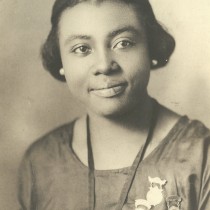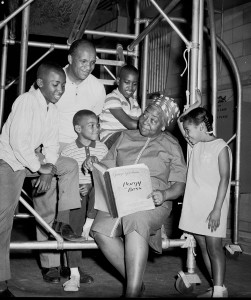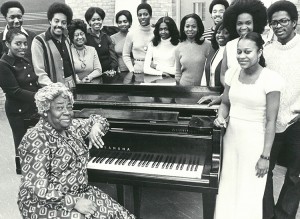Magazine

All the World’s a Stage
The daughter of former slaves, Eva Jessye would venture out from Kansas to lead a choir on Broadway, stand in Washington, D.C., with Dr. Martin Luther King Jr., and teach at the University of Michigan. Meet a woman who changed the face of the arts—and America.
by Davi Napoleon
September, 30, 1935. Boston.
The house lights dim. The music swells. Eva Jessye can’t guess that Porgy and Bess will be an international sensation, but as the out-of-town world premiere opens this night, she knows she’s in a show heading to Broadway. Not only is she appearing in the role of Strawberry Woman, but George Gershwin himself has selected her to lead her own choir in the show.
The Coffeyville, Kansas, native had known success before. When she moved to New York in 1926, she formed the Dixie Jubilee Choir, later renamed the Eva Jessye Choir. The troupe performed spirituals, work songs, mountain ballads, ragtime, jazz, and light opera in national and international tours. They recorded on major labels, including Columbia Records, and appeared on radio programs when CBS was only one small room on 57th Street.
By 1929, the Dixie Jubilee Choir had been in Hollywood movies, including King Vidor’s Hallelujah, which featured an all-Black cast. And in New York, Jessye directed her choir in the 1934 opera Four Saints in Three Acts. What made Four Saints groundbreaking wasn’t just that it experimented with form but that, for the first time, a multi-racial team had collaborated on music that wasn’t associated with Black culture.
Still, the opening night of Porgy and Bess in Boston changed Jessye’s life. For the next 30 years, no matter who was in or out of a production, she would lead her choir in every incarnation of the show. There was no doubt about it: Eva Jessye was not in Kansas anymore.
We Are Together
The first African American woman to direct a professional choral group, Jessye was recognized also as a singer, composer, actor, teacher, and poet. Her Bentley collection contains address books and travel logs, birthday cards and photographs, stock certificates and invoices, poetry and essays, programs—all gems of theatrical and Black history. Her collection makes it abundantly clear that a wall separated artists of color from their colleagues.
Jessye worked to change that.
Even before Porgy and Bess, she fought against discriminatory salaries, insisting that singers in her choir be paid for rehearsal time for Four Saints. She opposed discriminatory practices on the set for Hallelujah, too.
During the Washington run of a 1936 tour of Porgy and Bess, she joined the cast protest against segregation at the National Theatre, resulting in the first integrated audience in that venue.
When Porgy and Bess reached Dallas, “the cast could not eat in nearby places,” she scribbled in a notebook describing discriminatory conditions. Actor William Warfield, who played Porgy, found a good place for soul food in the predominantly Black part of town. The cast would have to walk there, but at least they’d eat well.

Eva Jessye holding a Porgy and Bess score in July 1965. Photo from the Eva Jessye papers at the Bentley Historical Library.
Jessye fought the racial divide on her own, too, at times in personal ways. In 1944, she headed for New York to adapt the Porgy and Bess score for a new company. The train was just pulling out of Florence, South Carolina, when she overheard a pregnant white woman tell her husband, a soldier, that she was hungry. Very hungry. “Can you get me anything at the next station? A candy bar even?” But the train didn’t stop long enough for him to make it to a vending machine, and as it pulled out again, she renewed her plea. The last call for dinner came, but how could the young couple afford inflated dining car prices? It was impossible, the husband said.
“I knew what it meant to be hungry,” Jessye recalled in her notes. She leaned over and offered to lend them money. The husband refused. She insisted, reminding him of how important food was to a pregnant woman. “They finally said they would eat, but only if I joined them in the dining car.” What pleased Jessye most was that when a steward looked at the interracial group with confusion, the husband said, “We are together.” When he asked for Jessye’s address to repay the loan when he could, she refused to give it to him.
In 1963, Dr. Martin Luther King Jr. called on the Eva Jessye Choir to become the official chorus of the March on Washington. Standing near the Lincoln Memorial, hearing speeches by A. Philip Randolph and Bayard Rustin, and then leading her choir were incredible experiences, but they weren’t the high point. That came when she was close by as Dr. King spoke about a dream that she would hold close forever.
In January 1983, Coretta Scott King invited Jessye to a celebration commemorating Dr. King’s birthday. “I had a wonderful time in Atlanta, witnessing the Martin Luther King event,” Jessye wrote to a friend. “There were hundreds of celebrities, 48 nations represented, and thousands of Black folks…I stood on the sidelines and drank it all in.”
“Sidelines” may be a misnomer, since Jessye had led the combined choruses of Atlanta University Center for the event. “Your beautiful, timeless music has been an inspiration to the thousands who have heard it,” Coretta Scott King wrote when thanking her.
Fill Up the Saucer
Born in 1895 to former slaves, Jessye went to live with relatives at age three, after her parents separated. While her mother worked, her Aunt Harriet sang comforting spirituals to the young girl. In 1927, Jessye compiled and arranged these African American songs, publishing them along with stories of her early life under the title My Spirituals. Jessye also composed her own choral works, sometimes based on classics, such as Paradise Lost and Regained and The Chronicle of Job.
Jessye began writing poetry before she was 10 years old. She was 12 when she organized her first performance group, a girl’s quartet, with a repertoire that consisted entirely of “spirituals or harmless ditties.” Jessye’s tastes were more eclectic, even then, but she feared being “churched,” meaning brought before church elders and charged with singing songs that didn’t reference God. In a town where the hospital didn’t admit patients of color, the church was a refuge, and alienating the elders was out of the question.
After graduating from Western University in Kansas, where she studied music, she earned a teaching certificate at Langston University in Oklahoma. She taught in segregated schools in Oklahoma, worked for an African American newspaper, and became director of music at Morgan College in Baltimore. There, the college president advised her not to teach classical music because it was “too far from the Black heritage,” an experience she documented more than 60 years later in notes for a memoir.
In the mid-1960s, she started working on Fill Up the Saucer, a backstage saga about the racial and theatrical intrigue she experienced on Porgy and Bess. Those who were involved in Porgy and Bess productions, and even some who weren’t, were excited by the prospect; letters poured in from Ira Gershwin, Dorothy Heyward, and Leonard Bernstein. Special praise came for the title, which she took from a line in Porgy and Bess, “Fill up the saucer ’til it overflow.”
“I’m honored to be part of a great lady’s book and memories,” actress and singer Pearl Bailey wrote in a letter dated May 13, 1986. “Dr. Eva Jessye—you achieved things in your profession at a time when others faltered or failed to realize they would.”
Jessye worked on the book on and off while continuing to contribute to the arts. During the 1960s, she appeared in the movies Black Like Me and Slaves. She was Queenie in a Broadway revival of Show Boat.
In 1989, she was featured in Brian Lanker’s photograph exhibit (and later book), I Dream a World: Portraits of Black Women who Changed America.
“A Self-Appointed Spokesman”
After her choir disbanded in the early 1970s, Jessye taught at U-M for a time, then went back to Kansas in 1979, where she was artist-in-residence at Pittsburg State University. In 1982, Governor John Carlin named her Kansas Ambassador for the Arts.

Jessye with U-M students at the University of Michigan in 1976. Photo from the Eva Jessye papers at the Bentley Historical Library.
But Jessye missed the lively world of Ann Arbor. In 1985, she moved back, taking up residence in a senior citizens’ complex on Packard.
“It is a wise and long overdue move…for cultural, social, and health reasons,” she wrote to a friend.
She donated her extensive collection of books, scores, artwork, and many personal and professional papers to U-M, beginning U-M’s African American Music Collection at the School of Music, Theatre & Dance, and establishing the Eva Jessye collection at the Bentley Historical Library.
Late in life, Jessye turned her full attention to four books started over the years, including her tale of “the personalities and activities of the actors” who worked on assorted productions of Porgy and Bess. “I am a self-appointed spokesman for the hundreds of artists who have helped make George’s dream come true,” she wrote to a friend.
She had not completed the book in February 1992, when she died in her sleep at age 97. The funeral was held at the First Presbyterian Church, and Willis Patterson, the associate dean of the School of Music, Theatre & Dance, spoke at the service. Jessye is buried in Ann Arbor’s Forest Hill Cemetery.
